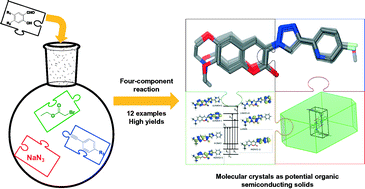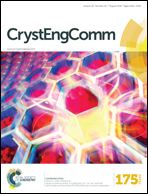Engineering organic semiconducting solids. Multicomponent access to crystalline 3-(4-aryl-1,2,3-triazolyl)coumarins†
Abstract
Crystalline 3-(4-aryl-1,2,3-triazol-1-yl)coumarins (ATCs) were prepared from commercial materials using a four-component methodology as a key step. In the present work, a feasible and environmentally friendly route to the title compounds was developed through the reaction between salicylaldehydes, ethyl bromoacetate, phenylacetylenes and sodium azide under mild conditions, with short reaction times and a simple workup. Crystalline solids are readily accessed from the featured products via solution processing and their arrays in the solid state were elucidated through SXRD; these molecules display a periodic overlap of π-systems, which facilitates carrier transport in organic electronic devices. Semiconductor band gaps for the obtained solids were derived through plane-wave DFT and compared with reference systems known to display superior performance in organic electronics. Thus ATCs represent attractive systems for research and implementation in molecular materials, a task which will be facilitated by the concise route herein described.


 Please wait while we load your content...
Please wait while we load your content...